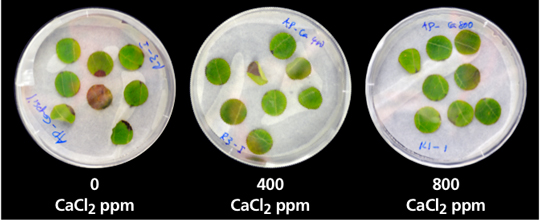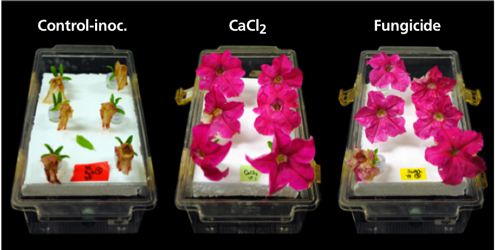1/29/2016
Alternative Compounds to Control Gray Mold
Uttara Samarakoon, Katherine Bennett, Jared Jent, Christina Chiu, Guido Sch
Gray mold caused by Botrytis cinerea is a widespread disease in ornamental plant production during propagation, production and post-harvest storage that readily infects flowers, stems or leaves. A common industry problem involves Botrytis infection of bedding plant flowers during post-harvest shipping. The most common example is meltdown of petunia flowers.
Despite growers sending plants with no symptoms of gray mold to the retailer, fungal spores may have already infected flower tissues in the greenhouse and remain latent until conditions for proliferation improve. Then, the pathogen develops during shipment causing necrotic flowers when they reach the market, resulting in unsellable plants. Being a fungus that develops well in cooler climates, ornamental plants marketed during the spring are highly vulnerable to gray mold. Plants are especially susceptible to Botrytis when the foliage is wet during transport or if the relative humidity is more than 94% inside the shipping racks and trucks.
Fungicide application prior to shipment is the most common control measure in bedding plants, however efficacy is limited. Fungicide resistance is an issue. Therefore, novel control methods are required.
Our research lab at Clemson University recently completed a research project with the support of the American Floral Endowment that focused on improving the tissue strength, sometimes called “toning,” of unrooted cuttings. During this project, we demonstrated the benefits of calcium and silicon for strengthening leaf tissue so that this tissue withstands the physical stress of the postharvest environment and resists fungal infection in the propagation environment (Figure 1). With this background, we launched a new project this past year focusing on the use of alternative chemicals to fungicides against gray mold on petunia flowers.
Figure 1. Disease incidence of Botrytis cinerea recorded six days after inocu-lation of poinsettia leaf discs following weekly applications of calcium chloride as a foliar spray to stock plants.

Beware of fungicide resistance
In order to do research with Botrytis, we collected isolates, or strains of fungi, from infected plant tissues at a commercial greenhouse. These isolates were first tested for resistance to seven fungicides commonly used for Botrytis control, including: boscalid, cyprodinil, fludioxonil, fenhexamid, iprodione, pyraclostrobin and thiophanate-methyl. We found that one of the isolates was resistant to all seven fungicides tested, which is a scenario in which no grower wants to find him or herself. To our knowledge, this is the first documented case of fludioxonil resistance in Botrytis from greenhouse-grown ornamentals.
Botrytis resistance to fungicides is not uncommon because this fungus is a particularly successful fungus for avoiding fungicidal activity. Resistance is primarily a result of repeated use of preventative fungicide applications. The two keys to avoid creating Botrytis-resistant strains in your greenhouses are fungicide class rotation and a reduction of the number of applications. In other words, don’t spray if you don’t have to and don’t repeatedly apply fungicides from the same chemical class. But as mentioned above, some Botrytis can develop resistance to multiple different chemical classes, which makes even the best rotational strategies ineffective.
Screening the efficacy of potential alternative products
Non-traditional disease management practices are currently in high demand in the greenhouse industry; therefore, we investigated several alternative products for Botrytis control. These products include: methyl jasmonate (a natural, stress-induced, defense-signaling hormone), calcium chloride and calcium silicate (both of which provide calcium to improve cell wall strength), quaternary ammonium salt (a biocide to disinfect the surfaces of the plant tissues) and benzyladenine (a plant hormone, cytokinin, that delays or inhibits the natural senescence of plant tissues). A fungicide was used as a control (375 g/kg cyprodinil and 250 g/kg fludioxonil). The alternative products were applied twice weekly for two weeks prior to inoculation and the fungicide was applied according to the label instructions.
In this study, petunia flowers were placed into a sealed container with free water so that the relative humidity was ~100%. Then the flowers were sprayed with a solution containing Botrytis spores. This is termed inoculation. The results showed that the benzyladenine (100 ppm) and the quaternary ammonium salt (150 ppm) applications to open petunia flowers caused phytotoxicity symptoms. The methyl jasmonate (8 ppm) application resulted in greater Botrytis infection than the inoculated control. The calcium chloride (500 ppm) treatment had the least disease development. In fact, some of the flowers within calcium chloride were resistant to infection for up to 67 hours following inoculation. Therefore, we concluded that calcium chloride was a potentially successful alternative chemical for petunia flower meltdown and the use of this compound was investigated further.
Calcium chloride
In our previous studies supported by the American Floral Endowment, we demonstrated the benefit of applying calcium chloride or calcium silicate to stock plants of poinsettia and geranium. The unrooted cuttings, treated while still on the stock plants, were more resistant to physical stresses experienced in the postharvest shipping environment. Thus, calcium proved to be useful at helping to “tone” the cuttings for improved performance.
This past year, we conducted a series of experiments comparing the use of calcium chloride to a fungicide that contains both cyprodinil and fludioxonil. Our results demonstrate that the calcium chloride treatments had significantly less Botrytis infection compared to the fungicide (Figure 2). The differences were even better when a fungicide-resistant isolate was used.
 Figure 2. Petunia flowers 48 hours following inoculation with a fungicide-susceptible isolate of Botrytis.
Figure 2. Petunia flowers 48 hours following inoculation with a fungicide-susceptible isolate of Botrytis.
Left to right: Inoculated control, calcium chloride (500 ppm), fungicide.
Based on this experiment, we can conclude that calcium chloride sprays delay disease development better or equal to the fungicide.
In these studies, calcium chloride was applied twice weekly for the two weeks prior to inoculating the petunia flowers with Botrytis spores. Concentrations from 400 to 800 ppm were effective. Higher rates are currently being tested.
Conclusions and future directions
The series of experiments that we conducted explored the development of sustainable solutions to Botrytis infection during the shipping of flowering petunias. Our results underscore the potential for rapid meltdown when petunia flowers are infected by a large population of spores. Also, spray applications of calcium chloride made prior to shipping displayed significant benefits in terms of flower petal resistance to Botrytis infection. Application of calcium chloride also provides an attractive, environment-friendly, disease control strategy that addresses the challenges posed by fungicide resistance. We anticipate that these results will be useful for application to other bedding plants as well.
In the coming year, we’ll continue to explore the use of calcium chloride for control of petunia flower meltdown. Specifically, higher concentrations, other forms of calcium and the ideal timing of application will be explored.
GT
The authors wish to acknowledge the American Floral Endowment and the Floriculture Research Alliance for the financial support of this project. Technical support from Meg Williamson and Suranga Basnagala is also gratefully acknowledged.
Uttara Samarakoon is a former post-doctoral researcher and currently an Assistant Professor at The Ohio State University-ATI. Katherine Bennett, Jared Jent, Christina Chiu are undergraduate students, and Guido Schnabel and James Faust are faculty at Clemson University.